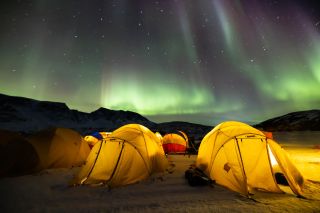Post-Traumatic Growth
Healing Psychological Wounds
Awe and teamwork in the Arctic.
Updated March 20, 2024 Reviewed by Ray Parker
Key points
- The documentary Operation Arctic Cure shows the positives of wilderness experience for veterans with PTSD.
- A reconnection with nature seemed to play a significant role in alleviating the veteran's emotional burdens.
- Team sports, nature walks, or mindful observation have the potential to achieve similar positive outcomes.
Journalist Bob Woodruff knows the trauma and adversity of war. While covering the war in Iraq in January of 2006, Woodruff and his cameraman Doug Vogt were severely wounded when an improvised explosive device (IED) rocked the vehicle they were riding in. Woodruff suffered severe brain trauma and other injuries. Like the thousands of soldiers and others injured in the war, Woodruff’s injuries launched a long struggle for recovery.
A Mission to Help
As devastating as Woodruff’s experience was, it reinforced and strengthened his empathy for wounded warriors and served as motivation for the establishment of the Bob Woodruff Foundation, a nonprofit organization whose mission is to “ensure that our nation’s veterans, service members, and their families—those who stood for us—have stable and successful futures.”[i]
Toward this aim, Woodruff recently released a National Geographic documentary entitled Operation Arctic Cure.[ii] The documentary follows the experiences of a small group of American war veterans—each dealing with his or her own unique challenges stemming from their combat experiences—as they trek on Baffin Island to view spectacular Mount Thor, located above the Arctic Circle. The expedition traversed harsh terrain in brutally cold conditions. All along the journey, Woodruff and his crew recorded the impact of this experience on the well-being of the participants.
In preparation for the expedition, Woodruff interviewed psychologists Dacher Keltner and Craig L. Anderson, both of the University of California, Berkeley’s Greater Good Science Center at the time, on the positive effects that a challenging wilderness experience may have on people experiencing stress-related disorders. At their suggestion, the expedition leaders collected a variety of stress measures, including stress hormone levels, facial expressions, sleep quality, and heart rate variability—before, during, and after the Arctic trek.
Awe and Wonderment
The veterans making the journey to Mount Thor were novices to trekking in extreme conditions. They had little prior experience with the extreme isolation and the physical demands unique to hiking in harsh Arctic terrain and weather. But as the expedition progressed, they adapted to the extreme conditions and bonded as a team. They began focusing their attention on the satisfaction of overcoming challenges in one of the most spectacular settings on the planet. Objective measures of stress began to decline. Stress hormones lowered, sleep improved, and they formed strong social bonds with each other and the supporting expedition leaders and film crew.

In one especially poignant moment during the journey, the veterans arose from the warmth and security of their tents one frigid night to behold the beauty of the northern lights. Undulating waves of color spread across the sky, illuminating the snow- and ice-covered mountains. In one of the remotest spots in North America, the veterans felt a sense of oneness with nature and a bond with something bigger than themselves.
Each day posed new challenges. One veteran, an amputee, began to suffer pain and cramps in her leg near the location of her amputated foot. The other veterans rallied around her, offering support by carrying her load and pulling her on a sled when the pain was too much for her to bear. Together, they overcame this and other difficulties to reach their goal of standing at the foot of Mount Thor.
Two weeks after returning from their adventure, the veterans expressed lowered subjective feelings of stress. Stress hormones were lower than levels measured before the trip, and sleep quality was markedly improved as well. In short, the expedition members benefited positively from their experiences.
The benefits of Operation Arctic Cure illustrate how bringing veterans together in a shared experience may alleviate lingering combat stress. From a positive psychology lens, the trek activated and reinforced positive virtues and character strengths among the participants. The sheer natural beauty of Baffin Island—unlike anything they had seen before—helped build a sense of perspective in which to view their lives and circumstances. Working together to overcome daily challenges reinforced the importance of teamwork. Planning, conducting, and reflecting on the trip strengthened social networks. In short, the veterans experienced a sense of awe and belongingness with nature and each other, resulting in a diminishment of the psychological toll caused by their combat experiences.
It’s the Experience, Not the Arctic Circle
Of course, trekking on Baffin Island is not something most veterans can arrange to do. However, the things that made this experience valuable are not dependent on that particular setting. Perspective, awe, teamwork, and social bonding can be nourished in far less exotic situations. Psychologists can work with veterans to understand and appreciate the character virtues and strengths that improve their well-being and to craft their own strategies for experiencing these benefits. One of my former West Point colleagues, a clinical psychologist, finds similar benefits in organizing horseback riding events with veterans. Team sports and nature outings represent other strategies to achieve these goals. Simply sitting in one’s yard and observing the daily wonders of nature may spur a sense of perspective and even awe if done mindfully.
The experimental psychologist in me would like to replicate this Arctic experience in a more systematic way. A larger “N” would be desirable. Random assignment to experimental or control groups would allow more valid conclusions. Additional dependent variables would reveal other possible positive benefits of a wilderness experience. It would be great to know if the positive benefits of the experience persist for longer than two weeks.
That said, demonstrations like Operation Arctic Cure stand on their own merit. They vividly illustrate both the struggle that veterans face and the hope they may have that, with time, patience, and support, they can not only recover from combat stress but excel and flourish going forward. In this manner, Woodruff and his foundation have given veterans who continue to struggle a vision of what their future may hold.
Note: The views expressed herein are those of the author and do not reflect the position of the United States Military Academy, the Department of the Army, or the Department of Defense.
References
[i] To learn more about the foundation, visit https://bobwoodrufffoundation.org/
[ii] Watch Operation Arctic Cure online at Nat Geo TV: https://www.nationalgeographic.com/tv/movies-and-specials/operation-arc…




